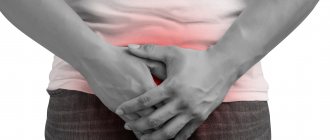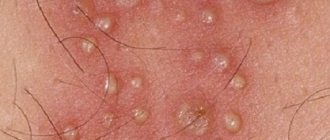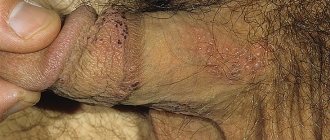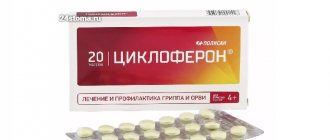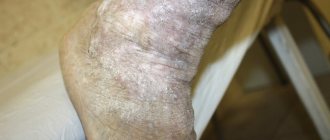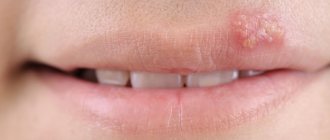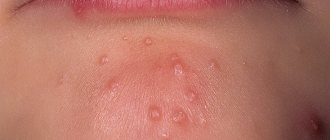Herpes in children
Clinical manifestations
The incubation period of the disease is 6 days (on average), but in different cases it can last 2-14 days. Localization of the pathological process allows us to distinguish between the following types of lesions :
- eye damage (manifested as blepharoconjunctivitis, conjunctivitis, keratitis, chorioretinitis, etc.);
- damage to the mucous membranes (manifested as stomatitis, tonsillitis, gingivitis, etc.);
- skin lesions (manifested as herpes of the nose, herpes of the lips, eyelids of the hands, face, etc.);
- genital herpes (damage to the vulva, penis, urethra, etc.);
- herpetic eczema;
- visceral forms (pneumonia, hepatitis);
- damage to the central nervous system (neuritis, meningoencephalitis, etc.).
The diagnosis usually indicates how widespread the lesions are (herpes: localized, widespread or generalized simplex). Course of the disease: acute, abortive, recurrent. The abortive form indicates a rapid, premature cessation of the painful process. A relapsing course indicates a recurrence of the disease in the form of recovery and a new return of symptoms. After the disappearance of clinical manifestations, there are antibodies in the blood, but the virus is present in the body without manifesting itself in any way. If an activation factor appears, it manifests itself and affects the same or other human organs.
One of the most common symptoms of herpes in children is damage to the mucous membranes. It manifests itself as acute stomatitis or gingivostomatitis. This symptom can occur in children of any age, but in most cases it occurs in children aged 2 to 3 years. The incubation period lasts from one to eight days. The disease has an acute onset with a rise in temperature to 39-40 °C. The child is shivering and begins to show anxiety (newborns and infants). General malaise appears. The baby refuses to eat because it causes pain in the mouth. Parents may notice active drooling and a characteristic odor from the mouth. In young children, body weight decreases, stomach upsets appear in rare cases, and dehydration is possible.
When the mucous membranes are affected, the inside of the mouth is swollen and reddish. The mucous membrane is covered with rashes ranging in size from 2 to 10 mm, which look like bubbles. At first they are transparent, and then yellowish contents appear. They soon burst, leaving behind the bubbles erosion. Regional lymph nodes are enlarged and painful (pain on palpation). The disease lasts from 1 to 2 weeks. On days 3-5, body temperature returns to normal. In some cases, relapses of the disease are possible.
Skin lesions most often occur around the mouth, nose and ears. A few days before the rash appears, there may be a burning sensation, as well as itching, tingling or slight pain. It is worth noting that the liquid in the bubbles that appear later may be mixed with blood. When the erosions that appear at the site of the bubbles heal, a brownish-yellowish crust appears. The crusts disappear soon, and in their place the skin may be red or slightly pigmented.
The blisters are often “grouped”; such groups of rashes are surrounded by a zone of hyperemia. The process of formation and drying of bubbles can last from 10 to 14 days. In some sick children, the blisters may coalesce into a large blister shape. After it opens (bursts), a large erosion forms in its place.
HSV causes localized and widespread skin lesions. Localized ones are characterized by the fact that the general condition of the patient does not worsen, the temperature is normal. The common (disseminated) form has an acute onset, body temperature reaches 39-40 ° C, which sometimes leads to chills. The child's general condition worsens, headaches appear, as well as pain in muscles and joints. At the height of symptoms, vomiting (or nausea) and convulsions occur. At the end of the first day (in rare cases, on the second or third day), herpetic blisters with a tendency to “group” appear simultaneously on the face, arms and torso. The disease lasts up to 14-21 days. In some cases - longer. This form of the disease predominates in younger children.
The next form of herpes is herpetic eczema . Occurs in children with eczema, neurodermatitis and other dermatoses in which there are erosive lesions (through which the infection enters the body). The disease is also called differently: Kaposi's smallpox rash, vacciniform pustulosis, eczema herpetiformis, etc.
The incubation period for herpetic eczema lasts from 3 to 5 days. An acute onset, sometimes a short prodromal period (before the “clinic” appears), the temperature rises to 39-40 °C. Symptoms (such as restlessness, lethargy, drowsiness, prostration) progress rapidly.
There is a possibility of convulsions and short-term loss of consciousness. From the first day of the disease, a profuse rash appears, sometimes it can appear only on 2-3 days. The rash lasts up to 2-3 weeks. Painful regional lymphadenitis occurs. At first the bubbles are transparent, then they become more cloudy and compacted. Elements of the rash on the second day resemble vaccine pustules. The bubbles merge with each other, burst, becoming covered with a crust. In severe cases, the rash leaves scars on the skin. The disease can last a long time, there is a possibility of repeated rashes over 2 or 3 weeks. On days 7-10, the body temperature returns to normal, and the patient’s general condition improves. After this, the skin begins to clear. If the child’s body is weakened, herpetic eczema has a severe course. The pathological process affects not only the mucous membranes and skin, but also the nervous system, visceral organs, eyes, which leads to death if untimely treatment and weakening of the body.
Due to the extent of skin damage, secondary bacterial infection poses a threat.
Eye damage (ophthalmoherpes) often develops due to infection with the herpes virus. It can manifest itself as an isolated lesion of the eye, but there are also frequent cases of a combination of damage to the eye, mucous membranes of the oral cavity and skin. Regional lymph nodes enlarge, follicular, catarrhal or vesicular-ulcerative conjunctivitis develops.
Ophthalmoherpes begins acutely, conjunctivitis, ulcers or sealed blisters appear on the skin of the eyelid near the eyelashes. The course of superficial herpetic keratitis is benign in most cases. Deep disc-shaped herpetic keratitis has a severe course, which often leads to inflammation of the anterior part of the vascular tract.
This is a torpid and often recurrent process. As a result of keratoiridocyclitis, clouding of the cornea and loss of vision can occur. Infants under 6 months of age may develop chorioretinitis, cataracts, and uveitis.
Genital herpes occurs in older children - teenagers and older. Transmitted sexually. In children of younger age groups, herpes simplex first appears, and the genitals are affected secondarily. In such cases, the virus is “picked up” through infected hands, linen, and towels. It is also possible that the external genitalia will be affected initially. Infection occurs through contact from parents with herpes simplex. The disease is most often caused by HSV 2.
Clinical manifestations of genital herpes vary. The course in most cases is persistent and recurrent. Genital herpes in adolescents and children of other ages causes vesicular and erosive-ulcerative rashes on the skin and mucous membrane of the genital organs.
In female patients, the rash can be localized on the labia minora and majora, in the perineum, and less commonly on the inner thighs. In even rarer cases, rashes may appear on the vaginal mucosa, clitoris, or anus. In male patients, the rash is localized on the inner layer of the foreskin and the skin of the scrotum. There may also be cases of a rash appearing on the mucous membrane of the urethra, which turns into a rash on the bladder. The disease manifests itself as fever, pain, itching, burning, etc. in areas affected by the disease. Genital herpes is more severe in adults than in children. After symptoms disappear, long-term latent virus carriage is possible, which increases the risk of infection to surrounding children and adults.
Damage to the nervous system due to herpes. Spread of the virus through the bloodstream can lead to infection of the brain. Damage to the central nervous system may have a course similar to meningoencephalitis, encephalitis, meningitis, meningoencephaloradiculitis. The most common forms of herpes are encephalitis and meningitis, which usually affect newborns and infants.
According to clinical manifestations, herpetic encephalitis does not differ from other viral encephalitis. In young children, a primary generalized infection often occurs, although damage to the central nervous system is possible simultaneously with the appearance of rashes on the lips, eyes, etc. Herpetic encephalitis begins acutely, with a very elevated temperature. The headache is severe, chills are felt, and repeated bouts of vomiting are possible. You need to observe the child, then you may notice lethargy and drowsiness, but in some cases, on the contrary, agitation. At the height of the disease, convulsions, fainting, paralysis and even impaired reflexes can occur. The course of the disease is severe, the consequences are serious. Particularly severe cases end in death. In such cases, autopsy shows acute hemorrhagic necrosis in the cerebral cortex.
Cerebrospinal fluid analysis shows lymphocytic cytosis and elevated protein.
Visceral forms manifest themselves in the form of acute parenchymal hepatitis, pneumonia, damage to the kidneys and other organs.
Herpetic hepatitis is common mainly among newborns, but also occurs in older children. Typically, hepatitis appears as a consequence of the generalization of herpes simplex, which results in damage to many organs of the child. But it is also possible, although rare, for isolated damage to the patient’s liver.
Herpetic hepatitis is manifested by high fever, severe symptoms of intoxication, drowsiness, respiratory distress, shortness of breath, cyanosis, enlarged liver, vomiting, enlarged spleen, etc. Jaundice, as with other forms of hepatitis, is also possible.
Herpetic pneumonia and herpetic focal nephritis are clinically no different from lesions of the lungs and kidneys of other etiologies. The disease has a course similar to that of a viral-bacterial infection. The course is acute or recurrent. Basically it is recurrent. The disease recurs due to hypothermia or overheating, attachment/activation of viral and bacterial infections. In girls, the period of a new exacerbation of the disease may be during menstruation. Relapses are usually mild.
Complications with herpes occur when a bacterial infection occurs.
Causes
The root cause of the appearance of a herpetic rash is considered to be the disappearance of the herpes virus into the body. There are several ways of infection:
- contact and household;
- airborne;
- during blood transfusion;
- during labor;
- autoinfection.
Blood test for herpes
Herpes simplex virus (HSV) types 1 and 2 cause genital infections and are the most common cause of genital ulcers.
However, not all patients undergo the virus from latent to open form. A number of factors contribute to this process:
- suppression the immune system against the background of exacerbation of concomitant diseases;
- exposure to stress;
- disruption routine ;
- lack of adequate nutrition;
- weakening of the body in the postoperative period;
- chronic fatigue;
- alcohol abuse ;
- taking medications that suppress the immune system;
- infection with AIDS or HIV.
Important! Once the herpes virus enters the body, it remains forever in the cells of the nervous system. When favorable conditions are created for it, it is immediately activated.
Treatment
It is currently impossible to get rid of the herpes virus forever. All therapeutic measures are reduced to the following:
Self-medication is dangerous with complications!
Attention
Despite the fact that our articles are based on trusted sources and have been tested by practicing doctors, the same symptoms can be signs of different diseases, and the disease may not proceed according to the textbook.
Pros of seeing a doctor:
- Only a specialist will prescribe suitable medications.
- Recovery will be easier and faster.
- The doctor will monitor the course of the disease and help avoid complications.
find a doctor
Do not try to treat yourself - consult a specialist.
- reduce the severity of symptoms;
- reduce the duration of the exacerbation period;
- avoid relapse.
Herpes type 3
Herpes type 3 is considered the most common infectious disease.
Treatment is comprehensive and includes taking systemic medications and applying ointments or creams to the lesions. In this case, the following groups of drugs are prescribed:
- antiviral;
- painkillers;
- immunomodulatory.
Among the most effective antiviral drugs in the fight against herpes are the group of cyclovir. Medications can be used not only externally, but also parenterally, orally, due to the fact that they are available in different forms. Their effectiveness has been proven in the treatment of most types of herpes virus.
In the initial stages of the disease, even before the characteristic rash appears, external remedies are also effective. They promote rapid healing of ulcers. In combination with an antihistamine, therapy gives maximum effect.
During the period of subsidence of the exacerbation, in order to speed up the healing process of the skin, drying and healing agents are additionally used.
Complications of herpes
Herpes is a common disease, the lack of treatment for which leads to serious consequences.
The use of antibacterial ointments will not be effective in the fight against viral infection, but will make it possible to avoid various complications of a bacterial nature.
Due to the fact that the main reason for the activation of the herpes virus is suppression of the immune system, immunomodulatory drugs are also prescribed. After receiving the results of the immunogram, the specialist will prescribe the most effective remedy and its dosage.
In cases where the patient suffers from severe pain and itching, painkillers are also prescribed.
Prevention
The only way to prevent infection with the herpes virus is to avoid contact with its carriers. Due to the fact that almost all people on the planet are infected with this virus, this preventive measure turns out to be ineffective.
The virus can remain in the human body for a long time and not manifest itself in any way. In order to prevent its activation, you should adhere to the following recommendations:
- maintain routine , devote enough time to rest and sleep;
- give up all bad habits;
- spend enough time outdoors ;
- eat properly and rationally
- exclude or minimize the intake of harmful foods (fried, smoked, sweet and spicy foods);
- observe basic rules of personal hygiene;
- treat all diseases in a timely manner
- if necessary, take vitamin complexes;
- exercise regularly or at least do exercises in the morning;
- avoid excessive physical activity;
- avoid stressful situations and learn to respond adequately to all problems;
- At the slightest manifestation of the disease, seek help from a specialist.
By constantly monitoring your health, devoting proper time to rest and sleep, patients can easily avoid relapses. It has been proven that the herpes virus enters the acute phase only when the immune system is suppressed and the body is unable to resist it.
